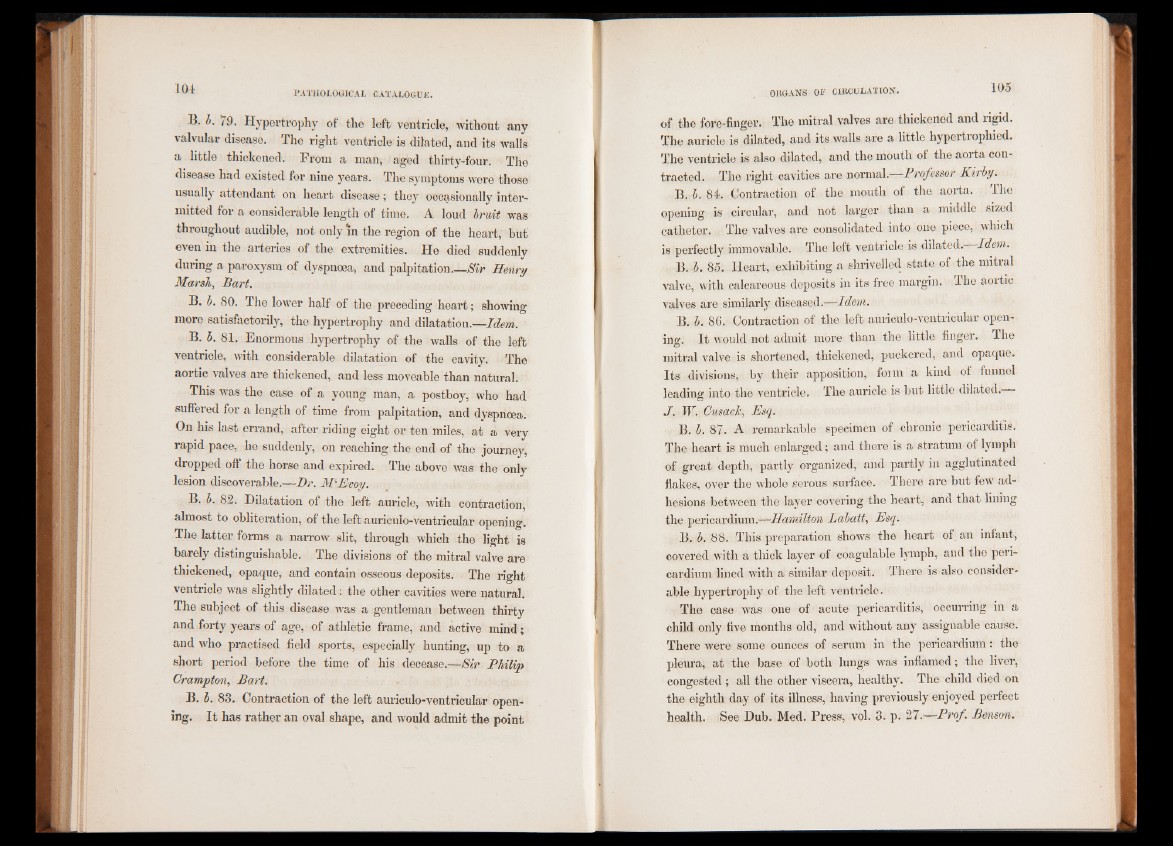
B. b. ;9. Hypertrophy of the left ventricle, without any
valvular disease. The right ventricle is dilated, and its walls
a little thickened. From a man, aged thirty-four. The
disease had existed for nine years. The symptoms were those
usually attendant on heart disease; they occasionally intermitted
for a considerable length of time. A loud bruit was
throughout audible, not only in the region of the heart, but
even in the arteries of the extremities. He died suddenly
during a paroxysm of dyspnoea, and palpitation__Sir Henry
Marsh, Bart.
B. b. 80. The lower half of the preceding heart; showing
more satisfactorily, the hypertrophy and dilatation.—Idem.
B. b. 81. Enormous hypertrophy of the walls of the left
ventricle, with considerable dilatation of the cavity. The
aortic valves are thickened, and less moveable than natural.
This was the case of a young man, a postboy, who had
suffered for a length of time from palpitation, and dyspnoea.
On his last errand, after riding eight or ten miles, at a very
rapid pace, he suddenly, on reaching the end of the journey,
dropped off the horse and expired. The above was the only
lesion discoverable.—Dr. M'Evoy.
B. b. 82. Dilatation of the left auricle, with contraction,
almost to obliteration, of the left auriculo-ventricular opening.
The latter forms a narrow slit, through which the light is
barely distinguishable. The divisions of the mitral valve are
thickened, opaque, and contain osseous deposits. The right
ventricle was slightly dilated: the other cavities were natural.
The subject of this disease was a gentleman between thirty
and forty years of age, of athletic frame, and active mind;
and who practised field sports, especially hunting, up to a
short period before the time of his decease.—Sir Philip
Crampton, Bart.
B. b. 83. Contraction of the left auriculo-ventricular opening.
It has rather an oval shape, and would admit the point
of the fore-finger. The mitral valves are thickened and rigid.
The auricle is dilated, and its walls are a little hypertrophied.
The ventricle is also dilated, and the mouth of the aorta contracted.
The right cavities are normal.—Professor Kirby.
B. b. 84. Contraction of the mouth of the aorta. The
opening is circular, and not larger than a middle sized
catheter. The valves are consolidated into one piece, which
is perfectly immovable. The left ventricle is dilated. Idem.
B. b. 85. Heart, exhibiting a shrivelled state of the mitral
valve, with calcareous deposits in its free margin. The aoitic
valves are similarly diseased.—Idem.
B. b. 86. Contraction of the left auriculo-ventricular opening.
It would not admit more than the little finger. The
mitral valve is shortened, thickened, puckered, and opaque.
Its divisions, by their apposition, fonn a kind of funnel
leading into the ventricle. The auricle is but little dilated.
J. W. Cusack, Esq.
B. b. 87. A remarkable specimen of chronic pericarditis.
The heart is much enlarged; and there is a stratum of lymph
of great depth, partly organized, and partly in agglutinated
flakes, over the whole serous surface. There are but few adhesions
between the layer covering the heart, and that lining
the pericardium.—Hamilton Labatt, Esq.
B. b. 88. This preparation shows the heart of. an infant,
covered with a thick layer of coagulable lymph, and the pericardium
lined with a similar deposit. There is also considerable
hypertrophy of the left ventricle.
The case was one of acute pericarditis, occurring in a
child only five months old, and without any assignable cause.
There were some ounces of serum in the pericardium: the
pleura, at the base of both lungs was inflamed; the liver,
congested; all the other viscera, healthy. The child died on
the eighth day of its illness, having previously enjoyed perfect
health. See Dub. Med. Press, vol. 3. p. 27.—Prof. Benson.